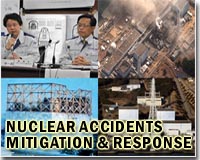| . |  |
. |
Osaka (AFP) March 24, 2011 Three workers at Japan's stricken Fukushima Daiichi plant were exposed to high radiation as they sought to restore power to reactor three, with two hospitalised, the nuclear safety agency said Thursday. "Three workers who were working to lay cables in the basement of the turbine building were exposed to radiation between 170 to 180 milli-sieverts," a spokesman for the Nuclear and Industrial Safety Agency (NISA) said. "Two were sent to hospital after they found themselves in a puddle of water. Although they wore protective clothing, the contaminated water seeped in and their legs were exposed to radiation." An exposure of 100 milli-sieverts per year is considered the lowest level at which any increase in cancer risk is evident. "Direct exposure to radiation usually leads to inflammation and so that's why they were sent to the hospital to be treated," the spokesman added. All three were workers with subsidiaries of Tokyo Electric Power Co. (TEPCO) which operates the crippled Fukushima Daiichi plant situated roughly 250 kilometres (155 miles) northeast of Tokyo. TEPCO said that a total of 14 workers have been exposed to at least 100 milli-sieverts since the March 11 quake and tsunami cut off the plant's power supply and knocked out backup systems, causing the cooling systems to fail. This left the fuel rods inside to heat up and evaporate water, threatening a full meltdown. The plant has been hit by explosions and fires and has emitted high levels of radiation, prompting the evacuation of tens of thousands. Fire and army crews have hosed down the reactors to cool them and topped up spent fuel rod pools in desperate measures intended to stop a major disaster, but also creating radioactive steam. The government has declared an exclusion zone with a radius of 20 kilometres around the power station, while telling those within 20 to 30 kilometres to stay indoors. "Contrary to being exposed to radiation by air, the workers were not sufficiently aware of the risk as they immersed their feet in the contaminated water," government spokesman Chief Cabinet Secretary Yukio Edano said. "They need to be treated thoroughly and we need to make efforts so this won't happen again," he added.
Share This Article With Planet Earth
Related Links Bringing Order To A World Of Disasters A world of storm and tempest When the Earth Quakes
 Japan resumes dousing smouldering nuclear plant
Japan resumes dousing smouldering nuclear plantOsaka (AFP) March 24, 2011 Emergency crew using fire engines again aimed their high-pressure water jets at a quake-hit and charred nuclear reactor in Japan Thursday, a day after a plume of dark smoke forced them to evacuate. Workers have struggled to avert a meltdown at the Fukushima plant northeast of Tokyo that has belched radiation, forcing tens of thousands to evacuate, contaminating farm produce and drinking wate ... read more |
|
| The content herein, unless otherwise known to be public domain, are Copyright 1995-2010 - SpaceDaily. AFP and UPI Wire Stories are copyright Agence France-Presse and United Press International. ESA Portal Reports are copyright European Space Agency. All NASA sourced material is public domain. Additional copyrights may apply in whole or part to other bona fide parties. Advertising does not imply endorsement,agreement or approval of any opinions, statements or information provided by SpaceDaily on any Web page published or hosted by SpaceDaily. Privacy Statement |